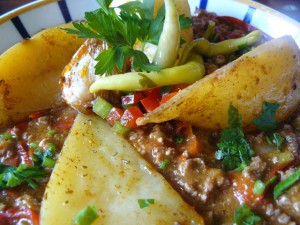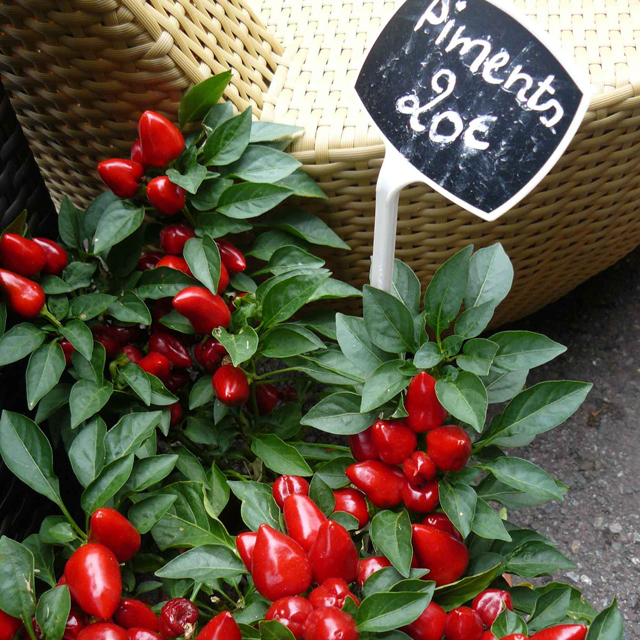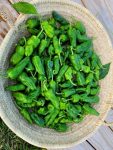Piment d’Espelette – the Basque region in a bite
It’s early September. You’re walking down the narrow, cobbled streets of a small town in southwestern France. The cool breeze carries a whiff of the ocean, not more than a few miles away. The tall, faded stone buildings provide a spot of shade in the strong afternoon sun. You’re surrounded by small shops and cafes. And everywhere you look, draping out of windows and off of balconies, there are bright red bunches of peppers. You’ve come to pepper season in the Basque country.
Peppers, called piments in French, have been grown in this region ever since they were brought here from their native Mexico in the 16th century. Trade is most active around the town of Espelette, about three miles north of Spain and five miles east of the Atlantic. The piment d’Espelette grown, dried, and ground here has become synonymous with the cuisine of the whole region. Since the 18th century, piment d’Espelette (or Ezpeletako Biperra in Basque) has replaced black pepper as the primary spice used in Basque cooking.
The peppers are grown today the same way that they were grown a hundred years ago. In spring, farmers start the pepper seedlings in long hothouses. By May, when the plants reach a height of about two feet, they’re planted outdoors by hand. Between August and November, the peppers begin to ripen. All autumn, the peppers are picked by hand, air-dried for at least 15 days, and finally baked at a low temperature to complete the drying process. Once dried, the peppers are ground, seeds and all, into a fine, copper-colored powder.
The Basques like to say that you need to have been raised under the hot sun of southern France to withstand the heat of the peppers. In reality, though, piment d’Espelette is pretty mild. The peppers score a grade of about 4,000 on the Scoville scale – about the same as a jalapeño, much lower than a habanero (which scores between 100,000–350,000). A pinch of piment d’Espelette adds a subtle spicy kick.
Along with the heat is a deep sweetness, similar to a roasted red bell pepper. When I asked Kitty Keller, who imports our piment d’Espelette, what she likes about the flavor, she commented, “it has so much more dimension than cayenne.” I think the Basques must agree, because they use it on just about everything. It’s rubbed on hams as they hang to cure. It’s stirred into stews, whisked into sauces, sprinkled on fish or greens. It’s even added to chocolate, both for drinking and in bar form. (Fun fact: Bayonne, the capital of the Basque region, was the first city in France to make chocolate.)
 When I visited the Basque region a few years ago, I was struck by the similarity between the food of southwestern France and that of the southwestern US – at least in terms of use of chiles. The Basque region is the only place in France that really cooks with piment d’Espelette, and piment d’Espelette is the only spice in France with an AOC. While I was there, I ate axoa (pronounced ah-shwa), which I described in my journal as “kind of like Basque chili.” That’s Texan chili, mind you – all meat and spice, no beans. For those, you have to head a few hours east to Languedoc-Roussillon for cassoulet.
When I visited the Basque region a few years ago, I was struck by the similarity between the food of southwestern France and that of the southwestern US – at least in terms of use of chiles. The Basque region is the only place in France that really cooks with piment d’Espelette, and piment d’Espelette is the only spice in France with an AOC. While I was there, I ate axoa (pronounced ah-shwa), which I described in my journal as “kind of like Basque chili.” That’s Texan chili, mind you – all meat and spice, no beans. For those, you have to head a few hours east to Languedoc-Roussillon for cassoulet.
My favorite way to use piment d’Espelette, though, is one of the simplest: toss a pinch into eggs and whip up an omelet. Add in some caramelized garlic, roasted bell pepper, cook in good olive oil and you have a damn fine lunch, Basque-style.





Zingerman’s Art for Sale